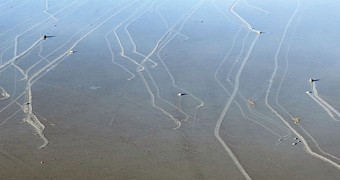Back in the 1940s, scientists documented a fairly bizarre phenomenon. In a nutshell, they noticed that rocks sitting on a dried lake bed located in the Death Valley National Park in California, US, kept moving around on their own.
Whenever embarking on such a mysterious journey, these rocks, some of which tipped the scale at a whopping 320 kilograms (roughly 700 pounds), left trails on the ground. Of these trails, some covered hundreds of meters.
Despite the fact that this phenomenon was first reported in the 1940s, it was only recently that scientists have managed to explain it. As detailed in a paper in the journal PLOS ONE, the mystery was solved with the help of footage showing the rocks cruising the dried lake bed.
As detailed by researchers with the Scripps Institution of Oceanography in the US, this footage, available below, was obtained by a team who decided to fit as many as 15 rocks with GPS tracking devices. A station monitoring weather conditions in the area was also set in place.
Writing in the journal PLOS ONE, the scientists behind this research project explain that the GPS devices and the station were deployed back in 2011. However, it was not until December 2013 that the rocks the researchers were stalking started moving.
At that time, the dried lake bed, dubbed the Racetrack Playa, was coated by a layer of water whose depth was one of just 7 centimeters (3 inches). During nighttime, this layer of water froze. On December 21, around noon, it started to melt, and the rocks began to move around.
It has thus been concluded that these so-called sailing stones of California's Death Valley cruise their dried lake bed aided by gentle winds that push them forward over the muddy ground, and bits and pieces of ice. Simply put, the phenomenon is the result of a rare combination of environmental factors.
By the looks of it, the rocks can be set in motion by winds whose speed is one of just 3 to 5 meters per second (about 9.8 to 16.4 feet per second). What's more, evidence indicates that layers of ice that are only 3 to 5 millimeters (0.11 to 0.19 inches) thick are more than enough to send them on their journey across the lake bed.
Due to the fact that they move at an average speed of merely 2 to 6 meters per minute (6.5 to 19.6 feet per minute), the rocks appear to be stationary when observed from a distance. “It’s possible that tourists have actually seen this happening without realizing it,” says specialist Jim Norris. “It is really tough to gauge that a rock is in motion if all the rocks around it are also moving,” he adds.
Seeing how this research project only focused on small and medium-size rocks, scientists plan to carry out future investigations. The goal is to establish if large rocks in California's Death Valley National Park move in the same manner. As Richard Norris puts it, “We have not seen the really big boys move out there. Does that work the same way?”

 14 DAY TRIAL //
14 DAY TRIAL //